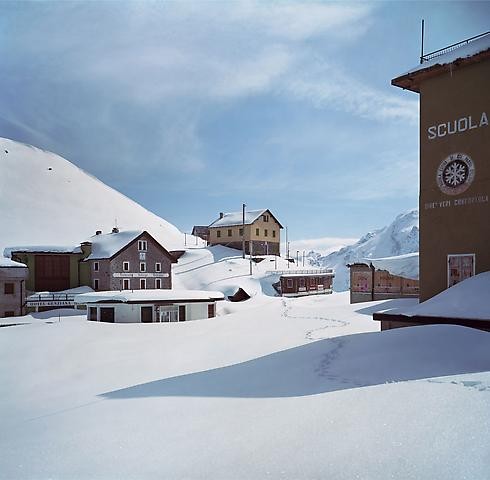Florian Maier-Aichen
03 Sep - 03 Oct 2009

© Florian Maier-Aichen
Untitled (Snow Machine), 2009
Chromogenic print
28 1/4 x 28 3/4 inches (72 x 73 cm)
Untitled (Snow Machine), 2009
Chromogenic print
28 1/4 x 28 3/4 inches (72 x 73 cm)
FLORIAN MAIER-AICHEN
"Snow Machine"
September 3 - October 3, 2009
Opening reception for the artist: Thursday, September 3rd from 6 to 8pm
6-24 Britannia Street
London WC1X 9JD
I have always been interested in the making of things. Most products and materials conceal their process of manufacture. It's the same with photography, which turned from a discipline that was subject to the mastery of the few (alchemists) into a readily available industrial mass product, too transparent and too technical.
—Florian Maier-Aichen
Gagosian Gallery is pleased to present an exhibition of recent photographs by Florian Maier-Aichen. This is the artist's first solo exhibition in London.
A photographer schooled on both sides of the Atlantic, Maier-Aichen's work reflects on the dual influences of the history of photography and the history of painting, whether drawing on such dichotomies as German Romantic painting and the pioneers of German "objective" photography, or applying his post-factum experience of American frontier art — from the Hudson River School and Abstract Expressionism to Land Art and West Coast conceptualism — to his own topographical depictions of landscape subjects. He focuses on the camera's consummate power to establish typologies of thought, perception, and feeling, producing images that, in mining the past, come to embody a matrix of issues salient to recent photographic practice.
Approaching the photographic field like a painter approaches a canvas, Maier-Aichen does for the contemporary image-world what pictorial photographers attempted in the nineteenth and early twentieth centuries, using the strategies and motifs of Romantic and Luminist painting. Unnaturally high-keyed or delicately tinted images of soaring mountain ranges, moody seas, and the industrial architecture of bridges, waterways, and dams carving through the natural landscape are all emanations of a rich and diverse imagination where a keen and critical grasp of art history coexists with more pronounced literary and cinematic conceits.
In a creative process that is as intensive as it is subtle and opaque, Maier-Aichen combines an exhaustive range of staged effects and traditional photographic techniques — albumen, silver-gelatin, and c-printing — with drawing and current computer-imaging processes. Weaving together often disparate elements from distinct sources, he applies myriad creative adjustments to each in order to produce seamless photographs that do not betray their intricate and layered compositions. Multiple negatives, digital manipulation, and elaborate studio techniques are employed to produce seemingly straightforward photographic landscape subjects while other images that engage the most conventional photographic techniques may themselves be subjects of pure fabrication.
Florian Maier-Aichen was born in Stuttgart, Germany in 1973. Recent solo exhibitions include the Museo Thyssen Bornemisza, Madrid (2008) and the Museum of Contemporary Art at Pacific Design Center, Los Angeles (2007). He lives and works in Cologne, Germany and Los Angeles.
"Snow Machine"
September 3 - October 3, 2009
Opening reception for the artist: Thursday, September 3rd from 6 to 8pm
6-24 Britannia Street
London WC1X 9JD
I have always been interested in the making of things. Most products and materials conceal their process of manufacture. It's the same with photography, which turned from a discipline that was subject to the mastery of the few (alchemists) into a readily available industrial mass product, too transparent and too technical.
—Florian Maier-Aichen
Gagosian Gallery is pleased to present an exhibition of recent photographs by Florian Maier-Aichen. This is the artist's first solo exhibition in London.
A photographer schooled on both sides of the Atlantic, Maier-Aichen's work reflects on the dual influences of the history of photography and the history of painting, whether drawing on such dichotomies as German Romantic painting and the pioneers of German "objective" photography, or applying his post-factum experience of American frontier art — from the Hudson River School and Abstract Expressionism to Land Art and West Coast conceptualism — to his own topographical depictions of landscape subjects. He focuses on the camera's consummate power to establish typologies of thought, perception, and feeling, producing images that, in mining the past, come to embody a matrix of issues salient to recent photographic practice.
Approaching the photographic field like a painter approaches a canvas, Maier-Aichen does for the contemporary image-world what pictorial photographers attempted in the nineteenth and early twentieth centuries, using the strategies and motifs of Romantic and Luminist painting. Unnaturally high-keyed or delicately tinted images of soaring mountain ranges, moody seas, and the industrial architecture of bridges, waterways, and dams carving through the natural landscape are all emanations of a rich and diverse imagination where a keen and critical grasp of art history coexists with more pronounced literary and cinematic conceits.
In a creative process that is as intensive as it is subtle and opaque, Maier-Aichen combines an exhaustive range of staged effects and traditional photographic techniques — albumen, silver-gelatin, and c-printing — with drawing and current computer-imaging processes. Weaving together often disparate elements from distinct sources, he applies myriad creative adjustments to each in order to produce seamless photographs that do not betray their intricate and layered compositions. Multiple negatives, digital manipulation, and elaborate studio techniques are employed to produce seemingly straightforward photographic landscape subjects while other images that engage the most conventional photographic techniques may themselves be subjects of pure fabrication.
Florian Maier-Aichen was born in Stuttgart, Germany in 1973. Recent solo exhibitions include the Museo Thyssen Bornemisza, Madrid (2008) and the Museum of Contemporary Art at Pacific Design Center, Los Angeles (2007). He lives and works in Cologne, Germany and Los Angeles.
